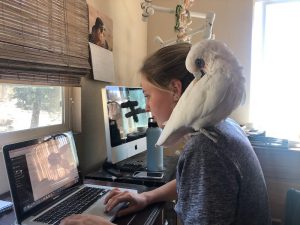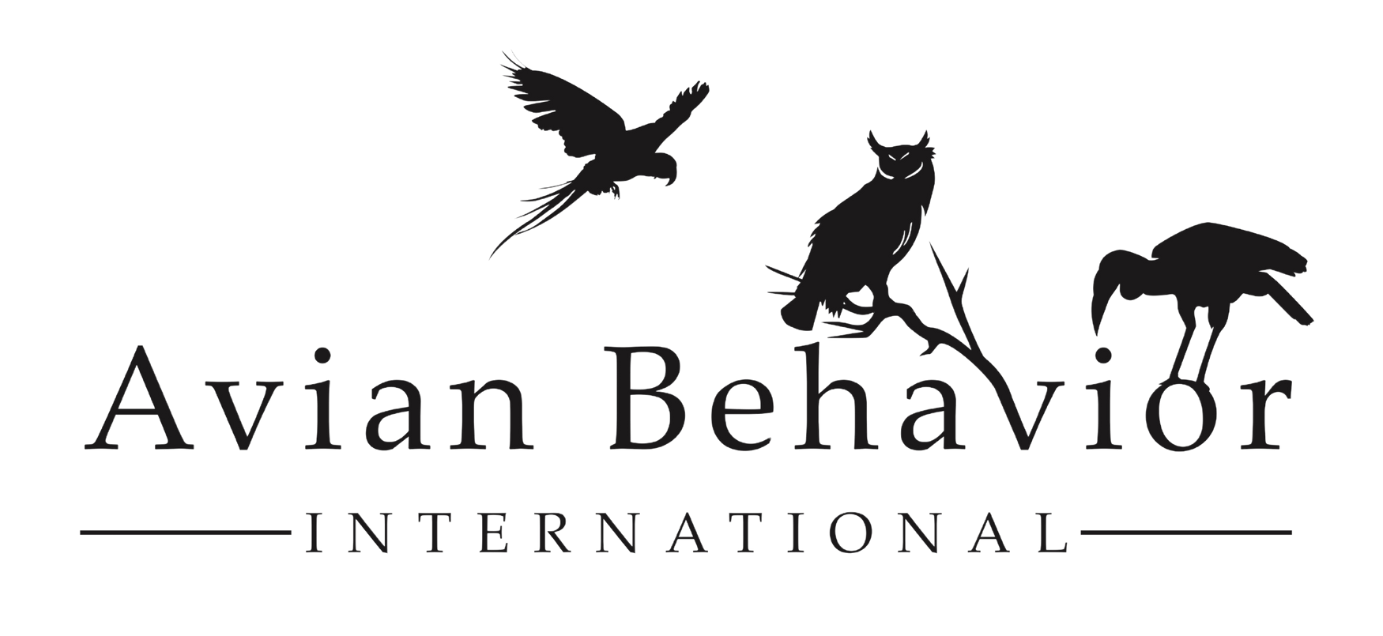
28 May Problem with a Parrot on Your Shoulder?
A human shoulder is a naturally wonderful place for a parrot to perch. She has everything she needs right there. A good view, good company, and the opportunity to go wherever her flock goes and see what her flock sees. For many parrot owners, shoulder sitting is the perfect source of companionship for their feathered friend, and it can also be source of frustration, biting and even stubborn behavior mythology as well. Is a parrot on the shoulder an inalienable right or a dangerous no-no? Let’s talk unpack this activity a bit and how it impacts your relationship with your friend and how we go about training your parrot not to bite when you want it to step off your shoulder.
There isn’t much not to like about being on a shoulder if you are a parrot. With a ready supply of reinforcers, riding on the shoulder can quickly become a parrot’s preferred mode of transportation. The social reinforcers are inherent: the human is right there. The parrot gets to go wherever they go, hear their voice, and be a part of every activity. Opportunity is another reinforcer. The human might snack, putting the parrot in the perfect place to snag some bits of food.
And don’t even get me started on toys! Glasses, earrings, hats, ears, buttons, seams, mouth, eyes, hair, jewelry, and so  much more! It’s all right there! And not only that, but when the parrot messes with something, the human will often follow up the parrot’s actions immediately with attention. That way, whenever the parrot wants the human to react, he can just push a button: grab an ear, another valuable, or nip the neck . The human has to react! The human might reach over and offer a few words or even a little beak wrestle; either one, it doesn’t really matter to the parrot. It’s better than sitting there unwatched.
much more! It’s all right there! And not only that, but when the parrot messes with something, the human will often follow up the parrot’s actions immediately with attention. That way, whenever the parrot wants the human to react, he can just push a button: grab an ear, another valuable, or nip the neck . The human has to react! The human might reach over and offer a few words or even a little beak wrestle; either one, it doesn’t really matter to the parrot. It’s better than sitting there unwatched.
This brings us to why shoulder sitting can be the perfect recipe for disaster. It puts our money maker very close to the dangerous part of a parrot: that beak. And the parrot can reach our most important parts of our body very quickly and easily from that vantage. Add in that it might get spooked or upset at unpredictable times, and we have a precarious situation.
That said, shoulder sitting is not inherently dangerous or safe. We have some powerful tools in the Lab to help you train important behaviors if you have a problem with your parrot stepping off your shoulder, as this can be the beginning of a dangerous road. If your parrot is an unpredictable biter or does not have a solid, positive-reinforcement based step up where it sees your hand and hops readily on, it is not recommended that you have your bird on your shoulder where it could potentially do irreparable harm. Sustainable solutions come in the form of teaching your parrot how you want success to look like rather than adding stressors to the environment like beak thumps, chest flicks and yelling NO! We have all been there, and it’s a horribly stressful cycle. Stopping a behavior is very different than ending it.
Just like bad habits in humans, these behaviors have a reason for your parrot. Adding roadblocks instead of replacing the behavior will only mean we have to keep increasing the intensity of our behavior. Again, just like trying to fix our vices, we might stop it, only to have to try a new fix that is even stronger than the last. Bitter sprays, harder thumps… These will lead to increasing frustration.
As we delve into in our Training Tidbit on Parrots on Shoulders in our membership lab, stepping a parrot off the shoulder can be a problem scenario if we don’t manage our conditions carefully. This is because through regular and consistent experience, the parrot learns that when a hand comes up to step them off the shoulder, nothing positive comes from that interaction. Typically, the step up on the hand, off the shoulder, the human puts them down and then social hour ends. The parrot can quickly learn the best way to avoid this outcome is to bite: bite the hand, ears, face, neck, anything that gets the human to stop. If this interaction escalates, it can become a very stressful interaction for both bird and human, complete with hair tangling, shirt diving, and blood drawn. The human might resort to scraping the parrot off the shoulder or having the parrot run down their back in a very intense game of cat and mouse.
These types of interactions are so common that they have spawned many myths about parrot behavior, one being that parrots feel dominant when they are on our shoulders or are in a cage with their eyes are above ours. The height dominance myth is a fallacy that has created many problems in the parrot world, from cages being way too small, lacking roominess, or not tall enough (even having some creative owners chopping the wheels and legs off of their cages to keep the parrots’ eyes below theirs), parrots not having access to outdoor aviaries or playgyms, to even more forceful  techniques for the owners to establish their dominance. Height dominance is a narrative that we tell ourselves without knowing or considering all of the information at hand. We may have some information, like when a parrot is up high, he avoids my hand or he bites because he is being bossier or exerting his dominance, but we don’t have the whole picture. If we look at how the parrot views the shoulder experience in its entirety, we can develop a completely different picture.
techniques for the owners to establish their dominance. Height dominance is a narrative that we tell ourselves without knowing or considering all of the information at hand. We may have some information, like when a parrot is up high, he avoids my hand or he bites because he is being bossier or exerting his dominance, but we don’t have the whole picture. If we look at how the parrot views the shoulder experience in its entirety, we can develop a completely different picture.
For instance, looking at the way your dog views going to the veterinarian’s office, he likely develops some fear based behaviors based on some of the affectations that come with vets: white coats, medicinal smells, cold, sterile floors, maybe even car rides if that’s one of the few times your dog goes in the car. That doesn’t mean he is inherently afraid of the vet’s office. It means he has learned from past experiences that going to the doctor isn’t usually a pleasant experience.
In this way, we can see where the height dominance construct as it relates to shoulder time and cage top play can be cast aside when more light is shed on it. By looking at the way the parrot experiences this entire interaction, from the moment the hand is presented to step up to the time the parrot is put away and the human walks off, we can see the way the parrot values the experience and how it will likely value it in the future: will it continue to want to step up in this specific scenario or won’t it? Like a dog going to the vet, they are quick to pick up the cues that provide them valuable information.
Changing the way we think about this convenient, enjoyable interaction is critical to the sustainability and safety we encounter moving forward. How we choose to perpetuate the mythologies that surround can have lasting impacts on the behavioral health on not only our parrots, but those in the parrot loving community. It’s never too late to learn something new!
At the Avian Behavior HQ, we have webinars from time to time for non-members, too! Plus, get free parrot behavior resources in your inbox getting on our email list!
Do you want professional mentorship and access to behavior inspo every day? Sign up for the Avian Behavior Lab. A basic membership allows parrot lovers access to a growing course library and a forum with dozens of topics for one on one guidance to your toughest challenges!

